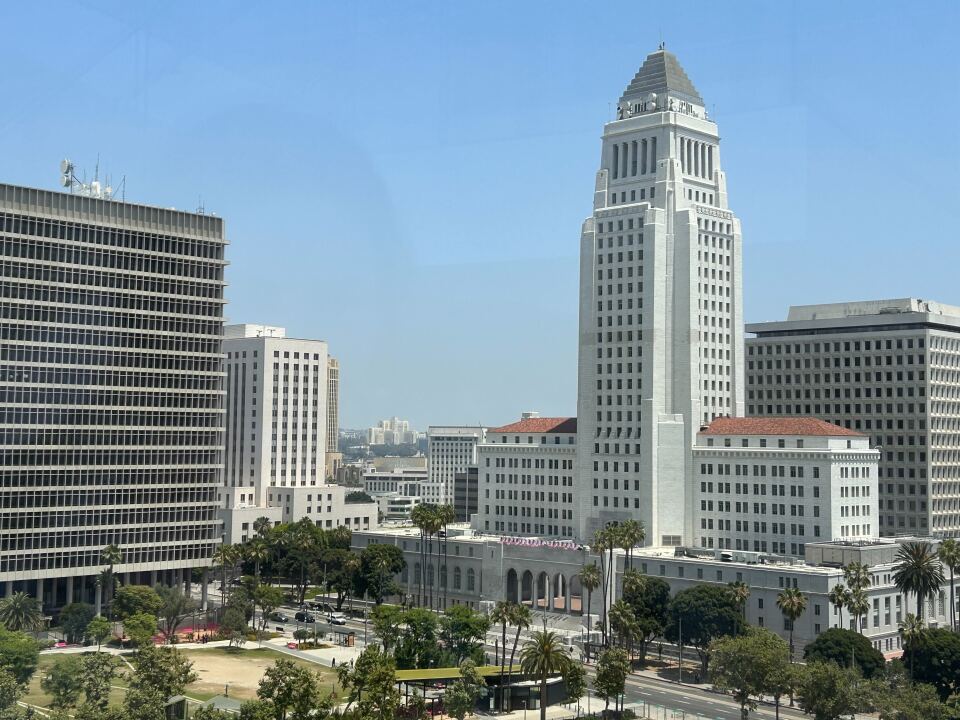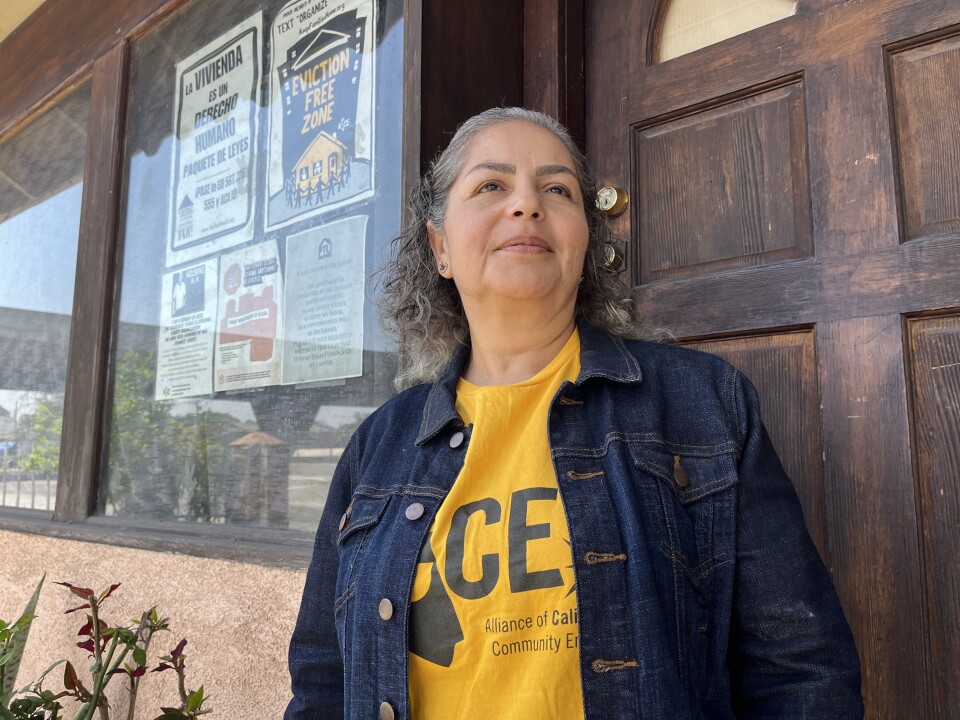Truth matters. Community matters. Your support makes both possible. LAist is one of the few places where news remains independent and free from political and corporate influence. Stand up for truth and for LAist. Make your tax-deductible donation now.
New LA rent hikes are coming in weeks. Why are rent control reforms still on hold at City Hall?

Rent gobbles up more than 30% of income for most tenants in the city of Los Angeles, putting 59% of L.A. renters in the federal government’s “cost-burdened” category. In a few weeks, many of those tenants could see their rent rise again.
New rent caps are scheduled to take effect next month for apartments covered by L.A. rent control. Increases could be as high as 5% — unless the City Council acts quickly on a pending proposal that would lower rent caps to 2%.
It’s been more than one year since an independent rent control study was submitted to the city, recommending changes that would reduce annual rent hikes. But so far, no council votes have been scheduled.
Tenant advocates say they’re frustrated by the delays on updating a formula that is now more than 40 years old.
“Other things have been prioritized, with the wildfires ... and the budget crisis,” said Pablo Estupiñan, a coordinator with the Keep L.A. Housed coalition. “There's a lack of commitment from council offices on moving forward.”
The report was commissioned by the City Council in 2023. It was submitted to the city in May 2024 by the Economic Roundtable, a local nonprofit research group. LAist made the study public after obtaining it through a public records request.
The 193-page report highlighted provisions in L.A.’s Rent Stabilization Ordinance that have benefited landlords at the expense of tenants. Based on the report’s findings, the L.A. Housing Department issued recommendations that — if passed — would lower allowable rent increases to 2% starting July 1.
A politically charged debate
A spokesperson for Councilmember Nithya Raman, chair of the council’s Housing Committee, said her office is working to schedule a vote this month on updating the rent control rules. But it’s unclear if the full council can pass an overhaul before council members begin their four-week summer recess on July 2.
Throughout this process, landlords have urged elected leaders to not further limit their ability to offset rising costs of property ownership.
The city "is creating a stifling environment,” said Fred Sutton, spokesperson for the California Apartment Association. “You had a four-year rent freeze. You had eviction moratoriums under COVID... The City Council is continuously sending signals to the entire world that it is not a safe place to do business.”
There were significant challenges for L.A. landlords during the pandemic, according to the Economic Roundtable report. Local restrictions on rent hikes and evictions for non-payment of rent came at a time when building maintenance, utility and insurance costs were rising faster than inflation.
Coupled with broad economic pressures, the city’s policies have convinced some landlords to leave the L.A. rental market. Bruce Painton told LAist that after owning a 33-unit rent-controlled apartment building for 11 years, he recently sold.
“Some months I had no income — it was all expenses,” Painton said of his experience during the pandemic. He said he now plans to buy real estate in Texas.
“They don't have all the fees and problems that we have in Los Angeles,” Painton said.

Balancing landlord and tenant interests
The Economic Roundtable report found that many landlords were able to absorb the shock of the pandemic because of turnover rates in rent-controlled apartments. About 40% of units became vacant between 2020 and January 2023. Under the city’s rent control rules, landlords are allowed to raise rents to higher, market rates when new tenants move in.
On the other side of the equation, the report found a significant number of L.A. renters are living on a financial knife’s edge. About 1-in-10 L.A. tenants are spending more than 90% of their income on rent alone.
Council members have been hearing from tenants like Cristina Campos, who told LAist she can’t afford the city’s current annual increases. She and her husband have lived for 23 years in a rent-controlled South L.A. apartment, where they raised two children who are now in college.
Campos said she already struggles to pay rent, and other units in their neighborhood are now renting at cost far out of her family’s reach.
“I always say, I don't want to go live with my neighbors under the bridge,” Campos said, speaking in Spanish. “But I might have to leave the unit if they keep raising the rents so high.”

Other tenant protections have stalled
The L.A. City Council passed some of the longest-lasting tenant protections in the nation during the COVID-19 pandemic. But recently, votes affecting tenants and landlords have become more politically fraught inside City Hall.
A proposal to temporarily freeze rents and limit evictions after the Palisades and Eaton fires failed after weeks of heated debate in council chambers. Similar protections were instead enacted by the L.A. County Board of Supervisors.
Dan Flaming, co-author of the Economic Roundtable report, said rent control policies are technically complex and politically charged. The issue directly pits the interests of landlords against those of renters, he said.
“It's contentious,” Flaming said. “It’s challenging for the council to parse this and enact changes to the status quo.”
How rent control currently works in L.A.
Rent control in L.A. generally applies to apartments built before October 1978. Those older units make up about 70% of all apartments in the city.
With about 64% of L.A. households renting rather than owning their homes, the city’s rent control policies play a huge role in housing affordability for hundreds of thousands of families.
Existing tenants in rent-controlled units can only have their rent raised by a set percentage each year. The limits change every year, ranging from 3% to 8%, depending on how high inflation is running in the L.A. area.
Landlords who pay for a tenant’s gas and electricity can add another 1% for each utility they cover, bringing L.A.’s maximum allowable rent hike to 10%. That’s much higher than in most other Southern California cities with rent control policies.
By comparison, rent hikes are capped at 3% in Santa Monica and Santa Ana, and up to 5% for certain units in unincorporated L.A. County.

Where do council members stand?
LAist contacted all 15 City Council district offices to ask where council members stand on updates to L.A.'s rent control policies. Only three took a firm position.
Spokespeople for Councilmembers Hugo Soto-Martinez and Eunisses Hernandez said they support capping rent hikes at 3%, in line with demands from Keep L.A. Housed.
A spokesperson for Councilmember Bob Blumenfield said he supports the recommendations from the L.A. Housing Department, which call for a new range of 2% to 5%.
Councilmembers Imelda Padilla, John Lee, Ysabel Jurado and Tim McOsker did not take a clear stance on the issue. Neither did Council President Marqueece Harris-Dawson or Housing Committee Chair Raman.
A spokesperson for Councilmember Curren Price noted that he recuses himself from votes on the city’s rent control policies because he is a landlord.
The offices of Councilmembers Adrin Nazarian, Katy Yaroslavsky, Monica Rodriguez, Heather Hutt and Traci Park did not respond to multiple requests for comment.
Why this matters now
The lack of clarity from city leaders comes just weeks away from new rent caps taking effect, despite acknowledgements from L.A. housing officials that the formula used to determine those limits is out of step with other rent control policies across the state.
Increases of up to 3% are scheduled for July 1, with the utilities bump bringing the maximum rent hike to 5%. That’s slightly down from the 4% to 6% range last year, when inflation was higher.
The authors of the Economic Roundtable study identified L.A.’s 2% utilities surcharge as a policy heavily weighted in favor of landlords. Those extra annual rent increases are higher than the actual increased costs of providing gas and electric service each year, the study found. Over time, the increases can exceed landlords’ total cost of providing those utilities.
Building on the study’s findings, the L.A. Housing Department recommended doing away with the 2% utilities bump. Housing department officials also agreed with the study’s recommendation to base annual rent hikes on a different measure of inflation, one that measures rising consumer costs but excludes shelter from the equation.
The Keep L.A. Housed proposal would further lower annual rent increases. Under the L.A. Housing Department’s recommendations, landlords would get at least a 2% increase each year. But the tenant advocacy group wants to let the city’s allowable increases go as low as 0% in years with flat or negative inflation.
Keep L.A. Housed also wants to end the current 10% bump landlords are allowed to charge when tenants bring additional residents into their household. The Housing Department did not recommend eliminating the increase for additional occupants.

Under proposals from both the L.A. Housing Department and Keep L.A. Housed, allowable rent increases would be 2% starting on July 1. If the council fails to act, rents will be allowed to rise between 3% and 5%.
Christina Boyar, an attorney with Public Counsel and a member of Keep L.A. Housed, said minor policy tweaks can greatly affect housing stability. Rent increases of an extra 1% or 2% each year compound over time, and can quickly outpace inflation and wage gains for many tenants.
“While it may seem like a small difference,” Boyar said, “that is hundreds of dollars for working families who are already struggling.”
Boyar pointed to a 2020 study from the U.S. Government Accountability Office that found a $100 increase in median rents is associated with a 9% increase in homelessness.











